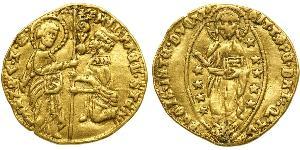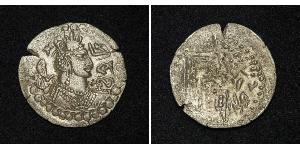(продана за $152.0)
1542, India, Vijayanagar Empire, Achyutaraya. Scarce Gold ½ Pagoda Coin. 1.69gm!
Country: India Culture: Vijayanagar Empire Mint Period: 1530-1542 AD Denomination: Gold ½ Pagoda Reference: Friedberg 362, Ramesan Type XXV. R! Condition: Crudely struck reverse, reddish deposits in fields, otherwise a nice VF! Ruler: Vijayanagar Empire, Achyutaraya (1530-1542 AD) Diameter: 11mm Material: Gold! Weight: 1.69gm
Obverse: Gandabherunda (double-headed eagle) standing left.
Reverse: Inscription in three lines. Legend: "śri pra/tapa chutya/raya"
The Gandaberunda or Berunda (Sanskrit: गण्डभेरुण्ड gaṇḍabheruṇḍa), is a two-headed mythological bird on the outskirts of the main Hindu mythology, believed to possess immense magical strength. It is used as the official emblem of the Karnataka state government because it is a symbol of strength. It is believed to be capable of fighting the forces of destruction. It appears as an intricately carved sculpture motif in Hindu temples.
The bird is generally depicted as clutching elephants in its talons and beaks, demonstrating its immense strength. In a coin(kasu) found in Madurai, it is shown holding a snake in its beak. All 2-dimensional depictions show a symmetrical image similar to the Double-headed eagle while other images show the long tail feathers resembling a peacock, which is the national bird of India. In the Chennakeshava temple of Belur, Karnataka, Gandaberunda (2-faced bird identified with Vishnu) is carved as a scene of "chain of destruction". Initially, a deer is prey to a large python, followed by being lifted by an elephant and a lion attacking the elephant, and the lion shown as devoured by Sharabha.[3] The Gandaberunda was a physical form displayed by Narasimha, Man-Lion incarnation of Vishnu.
After Narasimha had slain the demon Hiranyakashipu, he clung on to his dreadful form. Demigods were even more afraid of the lord than they were of the demon. Shiva -- Vishnu's best friend, incarnated as Veerabhadra Rudra and kala bhairava -- and Narasimha incarnated himself as Sharabha, a part-lion and part-bird beast. That became the terror of the lion. Gandaberunda -- with two heads, fearful rows of teeth, a black complexion and wide blazing wings -- fought Shiva-Sharabha for eighteen days and finally held it between his two beaks, killing Sharabha. However, he then exploded and got killed in the process.
The Vijayanagara Empire referred to as the Kingdom of Bisnagar by the Portuguese, was an empire based in South India, in the Deccan Plateau region. It was established in 1336 by Harihara I and his brother Bukka Raya I. The empire rose to prominence as a culmination of attempts by the southern powers to ward off Islamic invasions by the end of the 13th century. It lasted until 1646 although its power declined after a major military defeat in 1565 by the Deccan sultanates. The empire is named after its capital city of Vijayanagara, whose ruins surround present day Hampi, now a World Heritage Site in Karnataka, India. The writings of medieval European travelers such as Domingo Paes, Fernão Nunes and Niccolò Da Conti, and the literature in local languages provide crucial information about its history. Archaeological excavations at Vijayanagara have revealed the empire's power and wealth.
The empire's legacy includes many monuments spread over South India, the best known of which is the group at Hampi. The previous temple building traditions in South India came together in the Vijayanagara Architecture style. The mingling of all faiths and vernaculars inspired architectural innovation of Hindu temple construction, first in the Deccan and later in the Dravidian idioms using the local granite. Secular royal structures show the influence of the Northern Deccan Sultanate architecture. Efficient administration and vigorous overseas trade brought new technologies such as water management systems for irrigation. The empire's patronage enabled fine arts and literature to reach new heights in the languages of Kannada, Telugu, Tamil and Sanskrit, while Carnatic music evolved into its current form. The Vijayanagara Empire created an epoch in South Indian history that transcended regionalism by promoting Hinduism as a unifying factor.

|
Добавив:
anonymous 2017-09-02 |






















